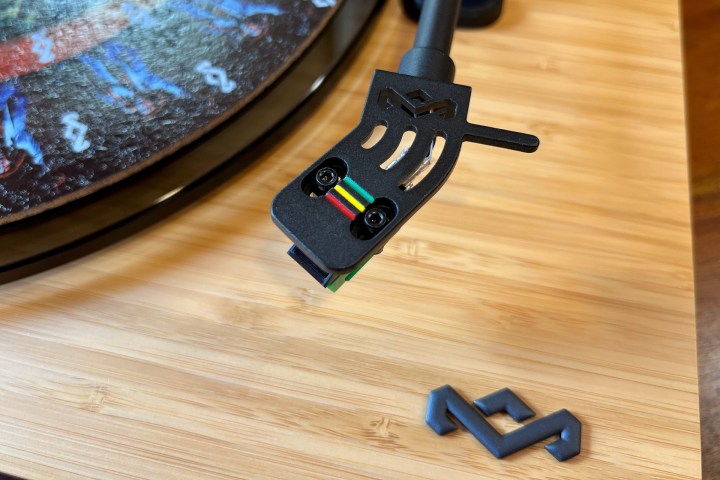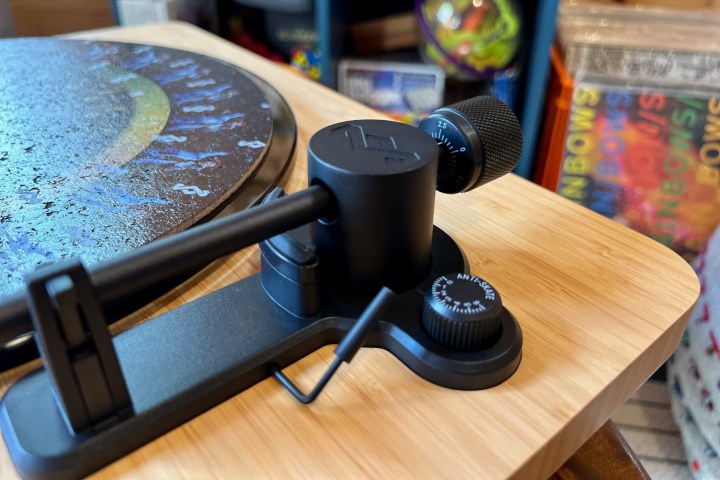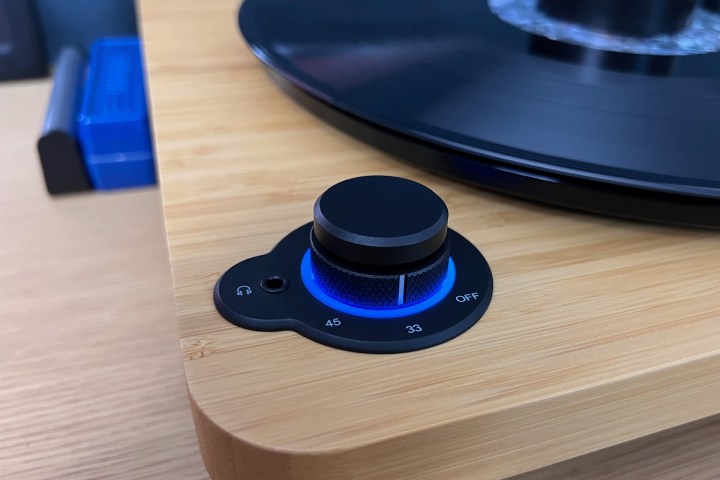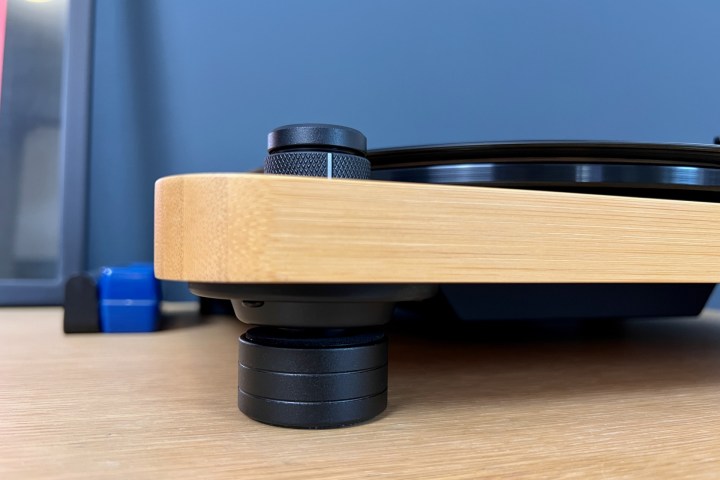“House of Marley fancies things up with the Stir It Up Lux, while clinging to its sustainable roots and solid sound.”
- Made with sustainable materials
- New glass platter
- Bluetooth connectivity
- Built-in phono preamp
- Easy setup and use
- Underwhelming zoetrope slip mat
- Sound needs some EQ tweaks
House of Marley, the audio brand started by reggae legend Bob Marley’s son Rohan, has been making stylish and well-designed audio gear that focuses on sustainability for more than a decade. Its flagship turntable, the Stir It Up, with its distinct, au naturel bamboo stylings and recycled materials, has long been appealing to record spinners with an environmental conscience and a discerning ear who are looking for a good balance of value and price.
House of Marley has for the first time given the Stir It Up turntable a nice little makeover. Branding the new deck with the “Lux” moniker, the entry-level to midrange Stir It Up Lux Bluetooth Turntable is sleeker (with chic black accents), has a gorgeous new glass platter, and a few other design upgrades that set it apart from its predecessors. But with that Lux naming also comes a more lux price, up $150 from the previous model to $400.
While you may still sleep easier at night knowing you’ve spent your money on a quality, eco-friendly product — and hats off to House of Marley for being one of few audio companies making this a priority — are the upgrades worth the extra dollars? We’re going to find out.
Stir It Up Lux: Setup
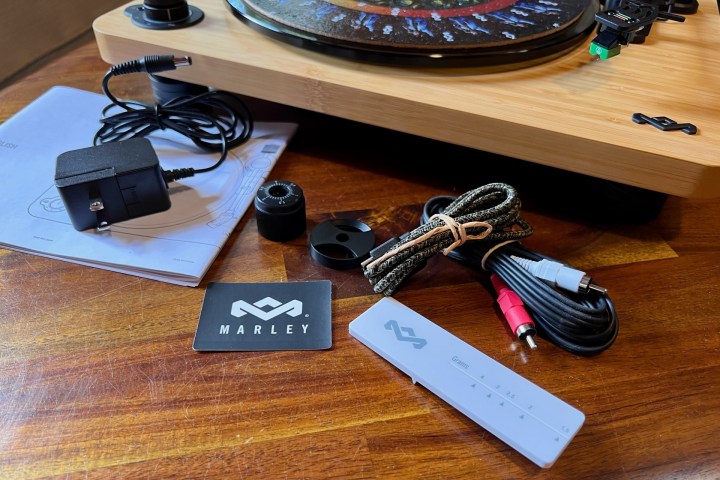
A turntable in the beginner-to-midlevel range like the House of Marley Stir It Up Lux should be simple to assemble and set up, and it should come with all the components and instruction guides necessary to get up and spinning in less than 10 minutes. The Lux ticks all these boxes. Everything is handily packed in recycled, molded cardboard inserts that keep all the delicate parts protected. There is a bit of assembly required with the Lux, though, but it’s all well laid-out in the included instruction guide, and you can also head online for more support if you need it.
While the headshell and cartridge come preinstalled and aligned in the box, like with any new belt-drive turntable, the rubber belt needs to be installed, the platter dropped in place, and the tonearm counterweight and anti-skate mechanisms calibrated. The Stir It Up Lux comes with everything you need to do this, including a stylus pressure gauge (the little white plastic seesaw thing pictured above), although I prefer to do it manually.
In the box, you’ll also find RCA cables, a power adapter with four international plug attachments, an adapter for playing 45s, and a USB-C cable that, surprisingly, is just for charging other devices with — such as the company’s Get Together speakers — and not for connecting to a computer so you can digitize your records.
And a special inclusion for the Lux is a reversible slipmat featuring a funky zoetrope design on one side that displays some trippy animated Bob Marley designs when it spins that you can space out to. The only thing missing from the Stir It Up Lux is a dust cover, which this line of turntables has never included.
Stir It Up Lux: Design and build

Overall build quality of the Stir It Up Lux is excellent. In keeping with House of Marley’s mandate of creating eco-friendly products, the Lux maintains the line’s tradition of having its plinth made from sustainable bamboo, which produces a natural and fresh look that has defined the company’s aesthetic in all its products. The Lux, however, has dropped the older models’ black plastic base enclosure, making for a much cleaner and leaner look.
The tonearm, tonearm base, counterweight assembly, sound-isolation feet, cue lever, speed select dial, and many other components of the turntable, are made from recycled aluminum and plastics. House of Marley has also opted to switch things up from the older models’ silver accents to the emphatically more “lux” black.
The aluminum tonearm is lighter, which House of Marley says makes for improved tracking and less distortion, and the headshell is still stamped with the green, yellow, and red stripes of the Rastafari, a nice nod to the company’s iconic namesake. The only negative I will point out with the tonearm is that the clip that holds it in its cradle is a bit too firm, and the review unit I received from House of Marley had a groove scratched on it from use.
- 1. Headshell with the Rastafarian colors.
- 2. Counterweight assembly
- 3. Speed switch and Bluetooth control
- 4. Sound isolation feet
One of the biggest upgrades with the Lux is the switch from aluminum to glass in the platter material. It’s designed to offer improved sound absorption for quieter and cleaner operation. Glass is heavier and denser than aluminum (the overall weight of the turntable has jumped from 9 pounds to 10 pounds total), and also better qulity, much like the glass and acrylic platters on higher-end turntables.
Lastly, can we talk about the zoetrope slipmat? I liked this eye-catching idea when House of Marley first announced the turntable and I was excited to check it out. The colorful cork mat, aside from helping further reduce resonance, promised “an unexpected animation that elevates your vinyl experience” with images of Bob Marley and trippy designs animating before your eyes. A good idea in theory, and points for originality, but experiencing it required shining an 11Hz strobe light on it or filming it with a camera that shoots in 11 frames per second. The instructions offer suggestions for strobe apps you can download so Android or iPhone devices can pull this off, but it’s underwhelming. It’s a cool slipmat, though.
Stir It Up Lux: Features

The House of Marley Lux is a belt-drive turntable that plays records at the standard 33 RPM and 45 RPM speeds, which are controlled with a sturdy selection dial on the bottom-right of the plinth. Lifting the tonearm into place sets the glass platter spinning, and I was impressed at how fast it gets up to speed — it’s on par with many direct-drive turntables I’ve used. The Lux also features auto-stop when a record reaches its end, which I personally think is a must-have these days, especially for absent-minded types like me who like to putter while listening to records. This way, I don’t have to worry about unnecessary wear on my stylus when a finished record keeps spinning as I clean the bathroom.
Another common feature with entry- and midlevel turntables is the Stir It Up Lux’s switchable built-in phono preamp, which makes the Lux ready to connect with any receiver/amplifier or set of powered speakers, without the need for a phono input or external phono stage. It’s a decent-sounding preamp for a $400 deck that puts the Lux easily on par with many turntables in its range.
The Lux is also well-advertised as a “wireless” turntable and features Bluetooth 5.3 connectivity for connecting to Bluetooth speakers and headphones. Pairing is easily done by pressing the speed dial, which, after pairing, also acts as a volume dial. But if wired headphones are more your jam, the Stir It Up Lux also has a 3.5-mm jack located at the base of the speed dial.
The other big influencer of a turntable’s sound quality is its cartridge. The Stir It Up Lux includes the midrange Audio-Technica AT-95E, the older version of A-T’s newer VM95E that I recently reviewed on the comparable Fluance RT81+ Elite. Audio Technica is well known for its quality cartridges, and the AT-95E can be found on entry- leve;and midrange record players from all kinds of manufacturers because of its low cost, replaceable stylus, and well-balanced, forgiving sound for a wide range of music. Should you want to, however, the Lux can be upgraded with a higher-end cartridge that you can easily install to the headshell.
Stir It Up Lux: How does it sound?

The House of Marley Stir It Up Lux sounds just as good as pretty much every other turntable in this range that I’ve heard, with only a few dings to consider.
I tested the Lux through a vintage Marantz 2230 receiver with the EQ set to flat. I used the Lux’s built-in preamp ,as well as an external Schiit Mani phono preamp, played through newer Wharfedale Diamond bookshelf speakers. For Bluetooth, I connected the Lux to the excellent Sonos Era 300.
Overall, the Lux sounds good for its price, with the AT-95E cartridge delivering the consistent dynamic range that it’s known for, even if the soundstage is a little narrower when compared to higher-end turntables with better cartridges, like the Ortofon 2M Blue on a U-Turn Orbit Theory, which I A/B tested just for reference.
On the low end, I found the Lux a little heavy and borderline boomy, especially on bass-saturated pop tracks from artists like Harry Styles (As It Was) and Billie Eilish (All the Good Girls Go to Hell). I played a wide range of records, from Stone Roses and Queens of the Stone Age to Beastie Boys and the Star Wars soundtrack. Luckily, the low-end boominess is easily reined in with some EQing, and music with tighter kick drum hits like rock and hip-hop actually benefit.
I obviously couldn’t conduct a review of a House of Marley turntable without playing some Bob Marley, which really helped me get a good sense of the mids and highs of the Lux. Like with the lows, a little EQ tweaking goes a long way, and I found the Lux lacking in definition and separation with the EQ set in the flat position. Turn up the treble, however, and those Three Little Birds starts singing. Across the track list of Marley’s Legend best-of record, and as the stylus reached its break-in time, definition and clarity improved. Buffalo Soldier’s trumpet hits and Stir It Up‘s backup vocals land just right in the mids, while that extra treble helped make cymbals and hi-hats shimmer better. I will note that if your system or speakers do not have any EQ adjustment capabilities, you may want to check your options.
Lastly, while I am not usually an advocate of vinyl over Bluetooth as the analog-to-digital conversion and compression required reduces the fidelity of the analog sound, many people new to vinyl are choosing Bluetooth turntables for how easily they can integrate into their existing systems without spending more on new components. That said, I thought the Lux sounded rich, clear, and warm through the Sonos Era 300 speaker over Bluetooth, even if it did seem to remove some of that nice vinyl crackle, which many listeners might like. Bear in mind, though, that the Era 300 is an amazing-sounding $450 speaker, so manage your expectations if you’re pairing to something more modest.
Stir It Up Lux: The bottom line
Turntables at this price have come a long way since the resurgence of vinyl a few years back, with manufacturers turning out good-sounding decks at decent prices to try and put one in the living room of anyone looking to add vinyl to their life. The House of Marley Stir it Up has consistently, and comfortably, lived in this echelon for years, and the Lux continues the tradition with a solid-sounding, easy-to-setup and use turntable with standout looks and all kinds of connectivity options that make it perfect for beginners and beyond.
While I can’t vouch for whether the upgraded glass platter, lighter aluminum tonearm and headshell, and other improvements have actually had any effect on the Lux’s sound over its older models, I can say that its sound and features are comparable to other turntables in the range, including the $300 Fluance RT81+ Elite, the $400 Pro-Ject E1, and the $219 Audio-Technica AT-LP60XBT, making it definitely worthy of consideration.
What may set the Stir It Up Lux apart from others, however, is House of Marley’s dedication to sustainability and the fact that its result is a beautifully built and designed turntable with a unique bamboo finish that’s sure to turn some heads in your home. That alone might be worth the extra $150.

